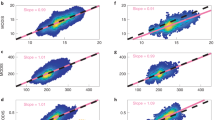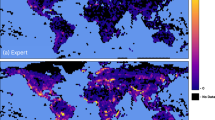Abstract
Clouds and aerosols provide unique insight into the chemical and physical processes of gas-giant planets. Mapping and characterizing the spectral features indicative of the cloud structure and composition enables an understanding of a planet’s energy budget, chemistry and atmospheric dynamics1,2,3,4. Current space missions to Solar System planets produce high-quality datasets, yet the sheer amount of data obtained often prohibits detailed ‘by hand’ analyses. Current techniques rely mainly on two approaches: identifying the existence of spectral features by dividing the fluxes of two or more spectral channels, and performing full radiative transfer calculations for individual spectra. The first method is not sufficiently accurate and the second is not easily scalable to the entire planetary surface. Here we have developed a deep learning algorithm, PlanetNet, that is able to quickly and accurately map spatial and spectral features across large, heterogeneous areas of a planet. We use PlanetNet to delineate the major components of the 2008 storm on Saturn5, enhancing the scope of the area previously studied and indicating regions that can be probed more deeply with radiative transfer models. Our spectral-component maps indicate compositional and cloud variations of the vast region affected by the storm, showing regions of vertical upwelling, and diminished clouds at the centre of compact substorms.
This is a preview of subscription content, access via your institution
Access options
Access Nature and 54 other Nature Portfolio journals
Get Nature+, our best-value online-access subscription
$29.99 / 30 days
cancel any time
Subscribe to this journal
Receive 12 digital issues and online access to articles
$119.00 per year
only $9.92 per issue
Buy this article
- Purchase on Springer Link
- Instant access to full article PDF
Prices may be subject to local taxes which are calculated during checkout




Similar content being viewed by others
Data availability
The data analysed in this work are available through the Planetary Data System (https://pds.nasa.gov). In addition, the data used for training PlanetNet are permanently archived and can be accessed with the permanent link: https://osf.io/htgrn or the DOI: https://doi.org/10.17605/OSF.IO/HTGRN.
Code availability
PlanetNet is publicly available through the UCL-Exoplanets GitHub page (https://github.com/ucl-exoplanets/). In addition, the code is permanently archived and can be accessed with the permanent link: https://osf.io/htgrn or the DOI: https://doi.org/10.17605/OSF.IO/HTGRN.
References
Fouchet, T. et al. Stratospheric aftermath of the 2010 storm on Saturn as observed by the TEXES instrument. I. Temperature structure. Icarus 277, 196–214 (2016).
Fletcher, L. N. et al. Thermal structure and dynamics of Saturn’s northern springtime disturbance. Science 332, 1413 (2011).
Barstow, J. K., Irwin, P. G. J., Fletcher, L. N., Giles, R. S. & Merlet, C. Probing Saturn’s tropospheric cloud with Cassini/VIMS. Icarus 271, 400–417 (2016).
Sánchez-Lavega, A. et al. An enduring rapidly moving storm as a guide to Saturn’s equatorial jet’s complex structure. Nature Commun. 7, 13262 (2016).
Baines, K. H. et al. Storm clouds on Saturn: lightning-induced chemistry and associated materials consistent with Cassini/VIMS spectra. Planet. Space Sci. 57, 1650–1658 (2009).
Brown, R. H. et al. The Cassini visual and infrared mapping spectrometer (VIMS) investigation. Space Sci. Rev. 115, 111–168 (2004).
Yu, S. X. & Shi, J. in Proc. Ninth IEEE Int. Conf. on Computer Vision Vol. 1, 313–319 (IEEE, 2003).
Wu, H. & Prasad, S. Convolutional recurrent neural networks for hyperspectral data classification. Remote Sens. 9, 298 (2017).
Yang, J., Zhao, Y., Chan, J. C. W. & Yi, C. in 2016 IEEE Int. Geosci. Remote Sensing Symp. 5079–5082 (IEEE, 2016).
Zhu, X. X. et al. Deep learning in remote sensing: a comprehensive review and list of resources. IEEE Geosci. Remote Sens. Mag. 5, 8–36 (2017).
Jolliffe, I. Principal Component Analysis (Springer, 2002).
Gurnett, D. A. et al. Radio and plasma wave observations at Saturn from Cassini’s approach and first orbit. Science 307, 1255–1259 (2005).
Fischer, G. et al. Analysis of a giant lightning storm on Saturn. Icarus 190, 528–544 (2007).
Fischer, G. et al. Atmospheric electricity at Saturn. Space Sci. Rev. 137, 271–285 (2008).
Baines, K. H., Carlson, R. W. & Kamp, L. W. Fresh ammonia ice clouds in Jupiter. I. Spectroscopic identification, spatial distribution, and dynamical implications. Icarus 159, 74–94 (2002).
Sromovsky, L. A., Baines, K. H. & Fry, P. M. Saturn’s great storm of 2010–2011: evidence for ammonia and water ices from analysis of VIMS spectra. Icarus 226, 402–418 (2013).
Bishop, C. M. Pattern Recognition and Machine Learning (Information Science and Statistics) (Springer, 2006).
Bengio, Y. Learning Deep Architectures for AI Vol. 2 (Now Publishers, 2009).
Goodfellow, I., Bengio, Y. & Courville, A. Deep Learning (MIT Press, 2016); http://www.deeplearningbook.org
Abadi, M. et al. TensorFlow: Large-scale Machine Learning on Heterogeneous Systems (TensorFlow, 2015); https://www.tensorflow.org/
Yu, S. X. & Shi, J. in Proc. Ninth IEEE Int. Conf. Computer Vision (ICCV 03) Vol. 2, 313 (IEEE Computer Society, 2003).
Ng, A. Y., Jordan, M. I. & Weiss, Y. in Advances in Neural Information Processing Systems 849–856 (MIT Press, 2001).
Pedregosa, F. et al. Scikit-learn: machine learning in Python. J. Machine Learning Res. 12, 2825–2830 (2011).
Luxburg, U. A tutorial on spectral clustering. Stat. Comput. 17, 395–416 (2007).
Griffith, C. A. et al. A corridor of exposed ice-rich bedrock across Titan’s tropical region. Nat. Astron. https://doi.org/10.1038/s41550-019-0756-5 (2019).
Acknowledgements
This project received funding from the European Research Council (ERC) under the European Union’s Horizon 2020 research and innovation programme (grant agreement number 758892, ExoAI) and under the European Union’s Seventh Framework Programme (FP7/2007–2013)/ERC grant agreement numbers 617119 (ExoLights). I.P.W. acknowledges funding by the Science and Technology Funding Council (STFC) (grants ST/K502406/1 and ST/P000282/1) and support from Microsoft Azure for Research cloud computing. C.A.G. is funded by the University of Arizona.
Author information
Authors and Affiliations
Contributions
I.P.W. developed the PlanetNet algorithm and conducted the data analysis. C.A.G. provided the calibrated Cassini/VIMS data and led the spectral interpretation of the data.
Corresponding author
Ethics declarations
Competing interests
The authors declare no competing interests.
Additional information
Journal peer review information: Nature Astronomy thanks Mario D’Amore and the other anonymous reviewer(s) for their contribution to the peer review of this work.
Publisher’s note: Springer Nature remains neutral with regard to jurisdictional claims in published maps and institutional affiliations.
Supplementary information
Supplementary Information
Supplementary Figures 1–14, Supplementary Table 1
Rights and permissions
About this article
Cite this article
Waldmann, I.P., Griffith, C.A. Mapping Saturn using deep learning. Nat Astron 3, 620–625 (2019). https://doi.org/10.1038/s41550-019-0753-8
Received:
Accepted:
Published:
Issue Date:
DOI: https://doi.org/10.1038/s41550-019-0753-8



